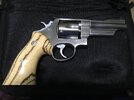halfmoonclip
Member
- Joined
- Feb 4, 2011
- Messages
- 2,793
Nice summary, mcb. What you've posted makes perfect sense. MIM is a fact of modern life in any case. It is amazing how nearly finished MIM parts have become.Both MIM and forging at simply cheap ways to get near net shape quickly. MIM typically requires less post machining as it is able to create finer details more consistently. Forging can sometimes get away with out heat treatment relying on the work hardening of the forging process. Though to get the most out of most alloys heat treatment is still required.
Thanks,
Moon


